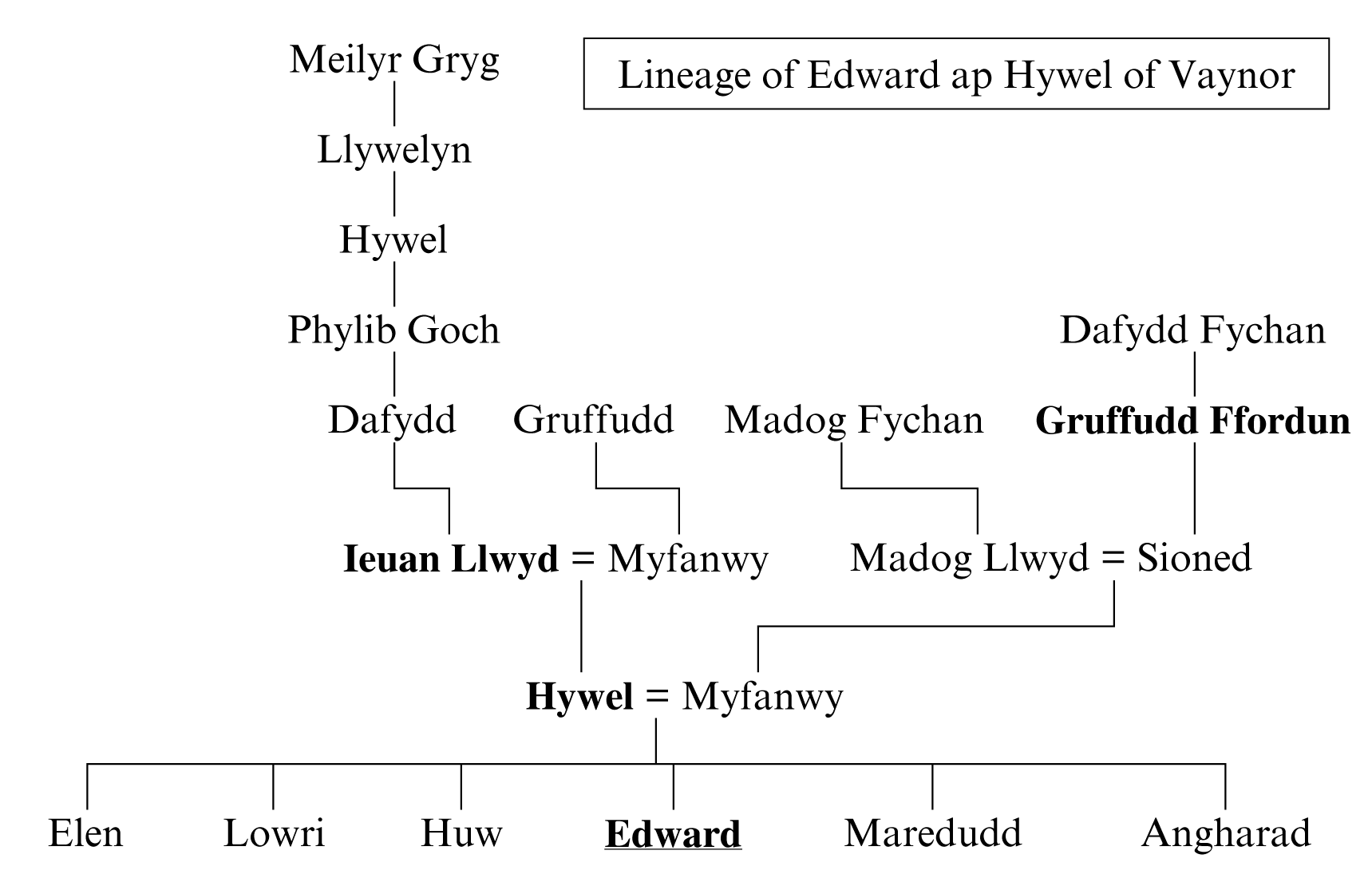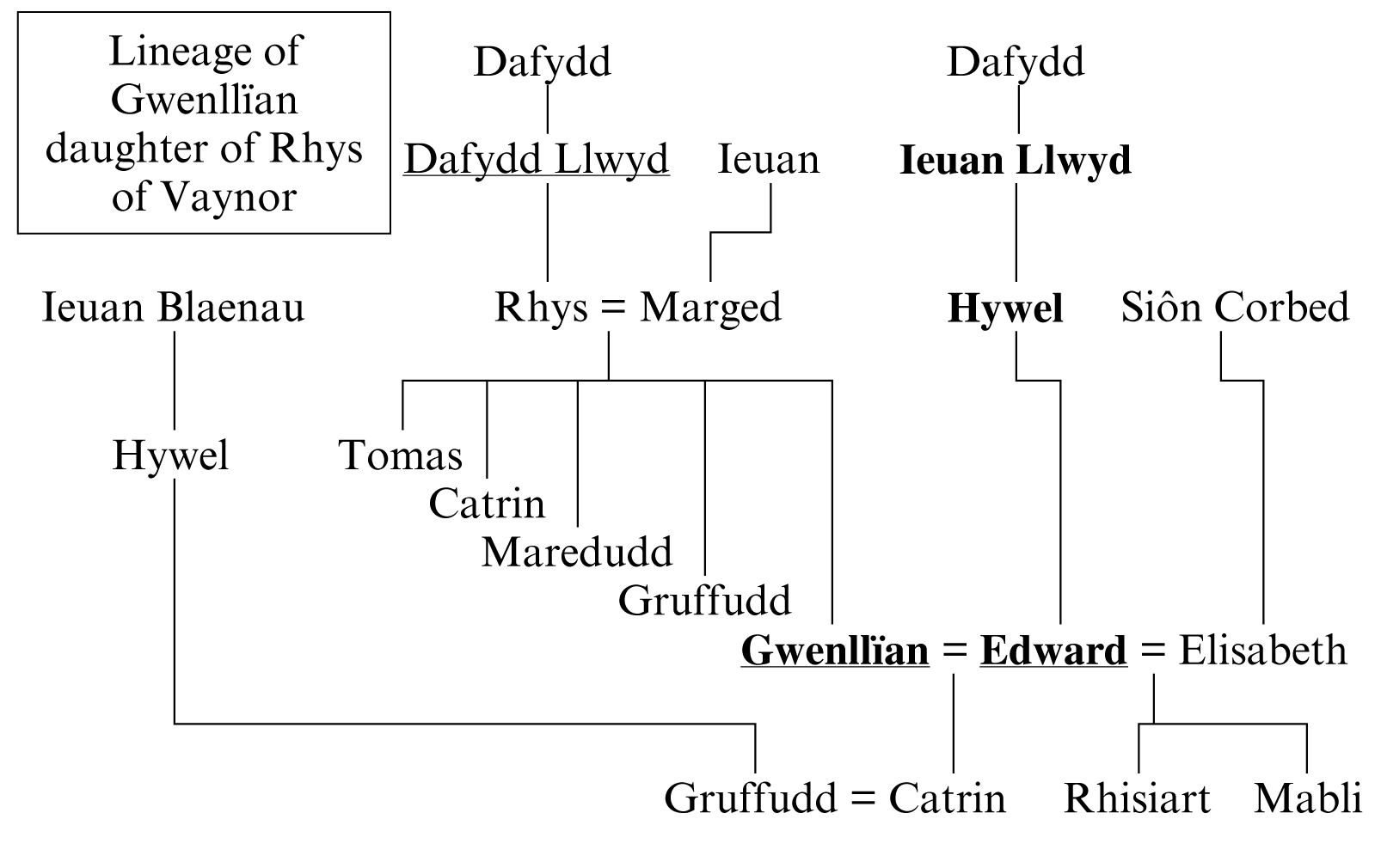Guto composed a poem of praise (poem 38) for both Edward ap Hywel of Vaynor and his wife, Gwenllïan daughter of Rhys. Only one other poem for Edward survives, namely a poem of praise by Owain ap Llywelyn ab y Moel (GOLlM poem 13). Gwilym ab Ieuan Hen composed two poem of praise for Edward’s parents, Hywel ab Ieuan Llwyd and Myfanwy daughter of Gruffudd (GDID poems IV and V). Guto composed a poem of praise (poem 37) for Gwenllïan’s grandfather, Dafydd Llwyd ap Dafydd of Newtown, and a number of poets also composed poems for her father, Rhys.
Lineage
The genealogical tables below are based on WG1 ‘Elystan Glodrudd’ 45, ‘Meilyr Gryg’ 1, 5; WG2 ‘Elystan Glodrudd’ 45 A1, ‘Meilyr Gryg’ 3A, 5A. People who are named by Guto in his poem for Edward are shown in bold, and the names of patrons are underlined.

Lineage of Edward ap Hywel of Vaynor
Edward’s father, Hywel ab Ieuan Llwyd, also had a son named Morus Goch with Siân daughter of Hywel and a daughter named Marian with Lady Broughton. The lineage shows that Edward was a descendant of Meilyr Gryg, who probably lived in Y Llwynmelyn in Tregynon, a parish in Cedewain (L. Dwnn: HV i, 283).

Lineage of Gwenllïan daughter of Rhys of Vaynor
Edward’s first wife was Gwenllïan daughter of Rhys of Newtown. On her father, Rhys ap Dafydd Llwyd, see Dafydd Llwyd ap Dafydd. Two of Gwenllïan’s nephews, Arthur ap Tomas and Mathau Goch ap Tomas, were sheriffs of the shire in 1548 and 1578. Edward’s second wife, Elisabeth, was the daughter of Siôn Corbed who gave patronage to Owain ap Llywelyn ab y Moel (GOLlM poem 14).
Catrin, the daughter of Edward and Gwenllïan, married Gruffudd ap Hywel ab Ieuan Blaenau (or Blayney). The National Library of Wales houses a collection of documents under the title of Vaynor Park Estate, the earliest of which dates to 1459. It notes that one Hywel ab Ieuan received the corn mill and fulling mill of Berriew from Richard duke of York (NLW Vaynor Park Estate 315). As the document was part of the Vaynor Park collection, this man was believed to be Edward’s father, Hywel ab Ieuan Llwyd, yet Thomas (1979: 91–109) argues that he was in fact Hywel ab Ieuan Blaenau.
Vaynor in Berriew
Edward and Gwenllïan lived in Vaynor in the parish of Berriew and the commote of Cedewain. It seems that Phylib Goch, Edward’s great-great-grandfather, lived in Vaynor at the beginning of the fourteenth century (WG1 ‘Meilyr Gryg’ 5). However, very little is known about the early history of the building. It is likely that Vaynor was effected by the revolt of Owain Glyndŵr during the early decades of the fifteenth century, when many houses belonging to the nobility in Powys were set alight (Huws 2007: 97–138). Many of these houses were rebuilt during the fifteenth century in line with the most recent architectural developments of the period (Suggett 1996: 28). However, no such evidence survives at Vaynor from the period, for the house was completely rebuilt in the seventeenth century (Haslam 1977: 43–6). The earliest parts of the house date to 1640. It is very likely, however, that Vaynor was an impressive medieval hall-house in the time of Edward and Gwenllïan (Silvester and Alfrey 2007: 39).
Bibliography
Haslam, R. (1977), ‘A Note on the Architecture of Vaynor Park’, Mont Coll 65: 43–6
Huws, B.O. (2007), ‘Ailadeiladu Bywyd ar ôl Gwrthryfel Glyndŵr: Tystiolaeth y Canu i Foelyrch’, Dwned, 13: 97–137
Silvester, R. and Alfrey, J. (2007), ‘Vaynor: A Landscape and its Buildings in the Severn Valley’, J. Finch and K. Giles (eds.), Estate Landscapes: Design, Improvement and Power in the Post-medieval Landscape (Woodbridge)
Suggett, R. (1996), ‘The Chronology of Late-Medieval Timber Houses in Wales’, Vernacular Architecture, xxvii: 28–37
Thomas, S.P. (1979), ‘A Postscript to “Branches of the Blayney Family” ’, Mont Coll 67: 91–108





